数据库开发-MySQL
在上次学习的内容中,我们讲解了:
- 使用DDL语句来操作数据库以及表结构(数据库设计)
- 使用DML语句来完成数据库中数据的增、删、改操作(数据库操作)
我们今天还是继续学习数据库操作方面的内容:查询(DQL语句)。
查询操作我们分为两部分学习:
- DQL语句-单表操作
- DQL语句-多表操作
1. 数据库操作-DQL
1.1 介绍
DQL英文全称是Data Query Language(数据查询语言),用来查询数据库表中的记录。
查询关键字:SELECT
查询操作是所有SQL语句当中最为常见,也是最为重要的操作。在一个正常的业务系统中,查询操作的使用频次是要远高于增删改操作的。当我们打开某个网站或APP所看到的展示信息,都是通过从数据库中查询得到的,而在这个查询过程中,还会涉及到条件、排序、分页等操作。
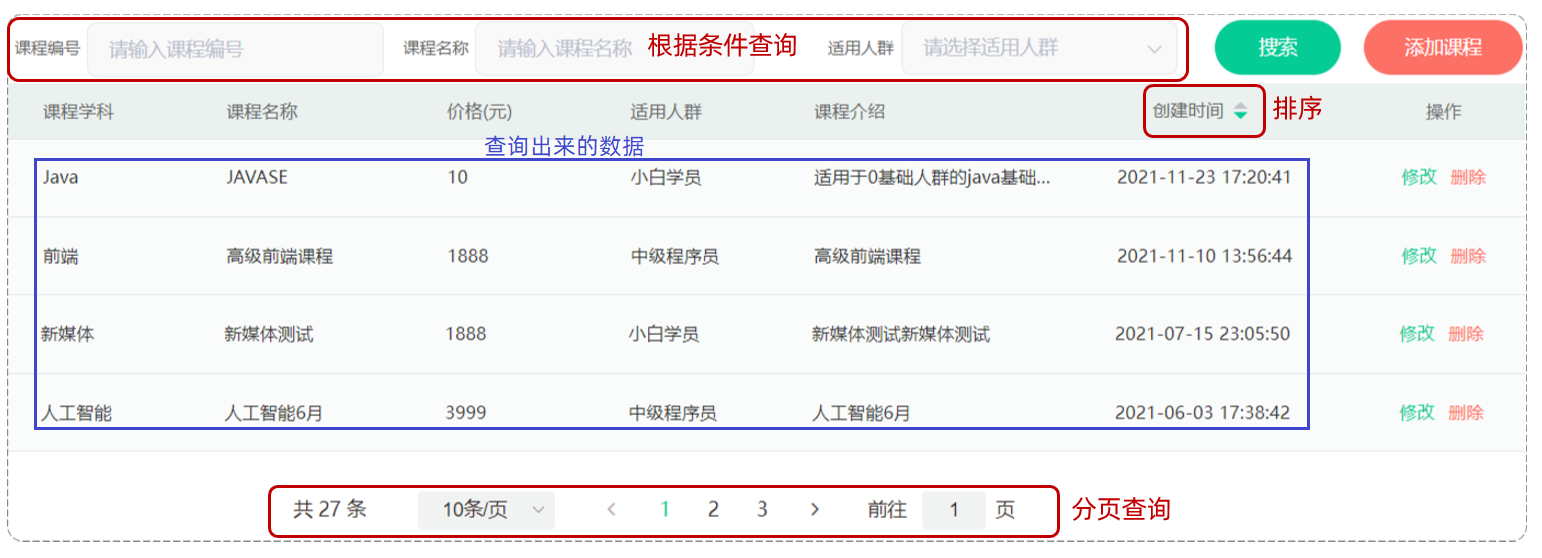
1.2 语法
DQL查询语句,语法结构如下:
SELECT
字段列表
FROM
表名列表
WHERE
条件列表
GROUP BY
分组字段列表
HAVING
分组后条件列表
ORDER BY
排序字段列表
LIMIT
分页参数我们今天会将上面的完整语法拆分为以下几个部分学习:
- 基本查询(不带任何条件)
- 条件查询(where)
- 分组查询(group by)
- 排序查询(order by)
- 分页查询(limit)
准备一些测试数据用于查询操作:
create database db02; -- 创建数据库
use db02; -- 切换数据库
-- 员工管理(带约束)
create table tb_emp (
id int unsigned primary key auto_increment comment 'ID',
username varchar(20) not null unique comment '用户名',
password varchar(32) default '123456' comment '密码',
name varchar(10) not null comment '姓名',
gender tinyint unsigned not null comment '性别, 说明: 1 男, 2 女',
image varchar(300) comment '图像',
job tinyint unsigned comment '职位, 说明: 1 班主任,2 讲师, 3 学工主管, 4 教研主管',
entrydate date comment '入职时间',
create_time datetime not null comment '创建时间',
update_time datetime not null comment '修改时间'
) comment '员工表';
-- 准备测试数据
INSERT INTO tb_emp (id, username, password, name, gender, image, job, entrydate, create_time, update_time) VALUES
(1, 'jinyong', '123456', '金庸', 1, '1.jpg', 4, '2000-01-01', '2022-10-27 16:35:33', '2022-10-27 16:35:35'),
(2, 'zhangwuji', '123456', '张无忌', 1, '2.jpg', 2, '2015-01-01', '2022-10-27 16:35:33', '2022-10-27 16:35:37'),
(3, 'yangxiao', '123456', '杨逍', 1, '3.jpg', 2, '2008-05-01', '2022-10-27 16:35:33', '2022-10-27 16:35:39'),
(4, 'weiyixiao', '123456', '韦一笑', 1, '4.jpg', 2, '2007-01-01', '2022-10-27 16:35:33', '2022-10-27 16:35:41'),
(5, 'changyuchun', '123456', '常遇春', 1, '5.jpg', 2, '2012-12-05', '2022-10-27 16:35:33', '2022-10-27 16:35:43'),
(6, 'xiaozhao', '123456', '小昭', 2, '6.jpg', 3, '2013-09-05', '2022-10-27 16:35:33', '2022-10-27 16:35:45'),
(7, 'jixiaofu', '123456', '纪晓芙', 2, '7.jpg', 1, '2005-08-01', '2022-10-27 16:35:33', '2022-10-27 16:35:47'),
(8, 'zhouzhiruo', '123456', '周芷若', 2, '8.jpg', 1, '2014-11-09', '2022-10-27 16:35:33', '2022-10-27 16:35:49'),
(9, 'dingminjun', '123456', '丁敏君', 2, '9.jpg', 1, '2011-03-11', '2022-10-27 16:35:33', '2022-10-27 16:35:51'),
(10, 'zhaomin', '123456', '赵敏', 2, '10.jpg', 1, '2013-09-05', '2022-10-27 16:35:33', '2022-10-27 16:35:53'),
(11, 'luzhangke', '123456', '鹿杖客', 1, '11.jpg', 2, '2007-02-01', '2022-10-27 16:35:33', '2022-10-27 16:35:55'),
(12, 'hebiweng', '123456', '鹤笔翁', 1, '12.jpg', 2, '2008-08-18', '2022-10-27 16:35:33', '2022-10-27 16:35:57'),
(13, 'fangdongbai', '123456', '方东白', 1, '13.jpg', 1, '2012-11-01', '2022-10-27 16:35:33', '2022-10-27 16:35:59'),
(14, 'zhangsanfeng', '123456', '张三丰', 1, '14.jpg', 2, '2002-08-01', '2022-10-27 16:35:33', '2022-10-27 16:36:01'),
(15, 'yulianzhou', '123456', '俞莲舟', 1, '15.jpg', 2, '2011-05-01', '2022-10-27 16:35:33', '2022-10-27 16:36:03'),
(16, 'songyuanqiao', '123456', '宋远桥', 1, '16.jpg', 2, '2010-01-01', '2022-10-27 16:35:33', '2022-10-27 16:36:05'),
(17, 'chenyouliang', '12345678', '陈友谅', 1, '17.jpg', null, '2015-03-21', '2022-10-27 16:35:33', '2022-10-27 16:36:07'),
(18, 'zhang1', '123456', '张一', 1, '2.jpg', 2, '2015-01-01', '2022-10-27 16:35:33', '2022-10-27 16:36:09'),
(19, 'zhang2', '123456', '张二', 1, '2.jpg', 2, '2012-01-01', '2022-10-27 16:35:33', '2022-10-27 16:36:11'),
(20, 'zhang3', '123456', '张三', 1, '2.jpg', 2, '2018-01-01', '2022-10-27 16:35:33', '2022-10-27 16:36:13'),
(21, 'zhang4', '123456', '张四', 1, '2.jpg', 2, '2015-01-01', '2022-10-27 16:35:33', '2022-10-27 16:36:15'),
(22, 'zhang5', '123456', '张五', 1, '2.jpg', 2, '2016-01-01', '2022-10-27 16:35:33', '2022-10-27 16:36:17'),
(23, 'zhang6', '123456', '张六', 1, '2.jpg', 2, '2012-01-01', '2022-10-27 16:35:33', '2022-10-27 16:36:19'),
(24, 'zhang7', '123456', '张七', 1, '2.jpg', 2, '2006-01-01', '2022-10-27 16:35:33', '2022-10-27 16:36:21'),
(25, 'zhang8', '123456', '张八', 1, '2.jpg', 2, '2002-01-01', '2022-10-27 16:35:33', '2022-10-27 16:36:23'),
(26, 'zhang9', '123456', '张九', 1, '2.jpg', 2, '2011-01-01', '2022-10-27 16:35:33', '2022-10-27 16:36:25'),
(27, 'zhang10', '123456', '张十', 1, '2.jpg', 2, '2004-01-01', '2022-10-27 16:35:33', '2022-10-27 16:36:27'),
(28, 'zhang11', '123456', '张十一', 1, '2.jpg', 2, '2007-01-01', '2022-10-27 16:35:33', '2022-10-27 16:36:29'),
(29, 'zhang12', '123456', '张十二', 1, '2.jpg', 2, '2020-01-01', '2022-10-27 16:35:33', '2022-10-27 16:36:31');1.3 基本查询
在基本查询的DQL语句中,不带任何的查询条件,语法如下:
-
查询多个字段
select 字段1, 字段2, 字段3 from 表名; -
查询所有字段(通配符)
select * from 表名; -
设置别名
select 字段1 [ as 别名1 ] , 字段2 [ as 别名2 ] from 表名; -
去除重复记录
select distinct 字段列表 from 表名;
案例1:查询指定字段 name,entrydate并返回
select name,entrydate from tb_emp;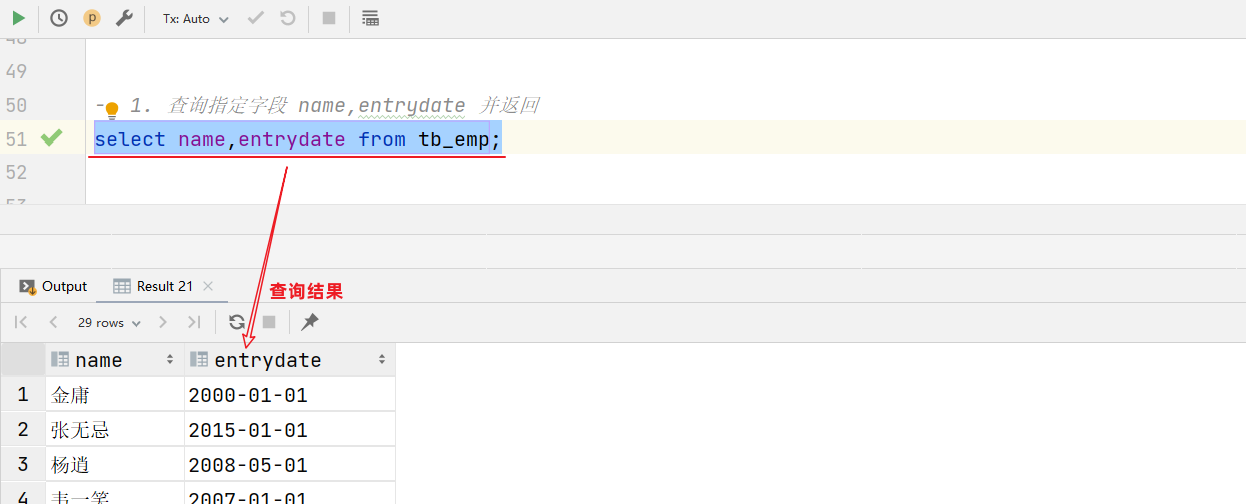
案例2:查询返回所有字段
select * from tb_emp;
*号代表查询所有字段,在实际开发中尽量少用(不直观、影响效率)

案例3:查询所有员工的 name,entrydate,并起别名(姓名、入职日期)
-- 方式1:
select name AS 姓名, entrydate AS 入职日期 from tb_emp;
-- 方式2: 别名中有特殊字符时,使用''或""包含
select name AS '姓 名', entrydate AS '入职日期' from tb_emp;
-- 方式3:
select name AS "姓名", entrydate AS "入职日期" from tb_emp;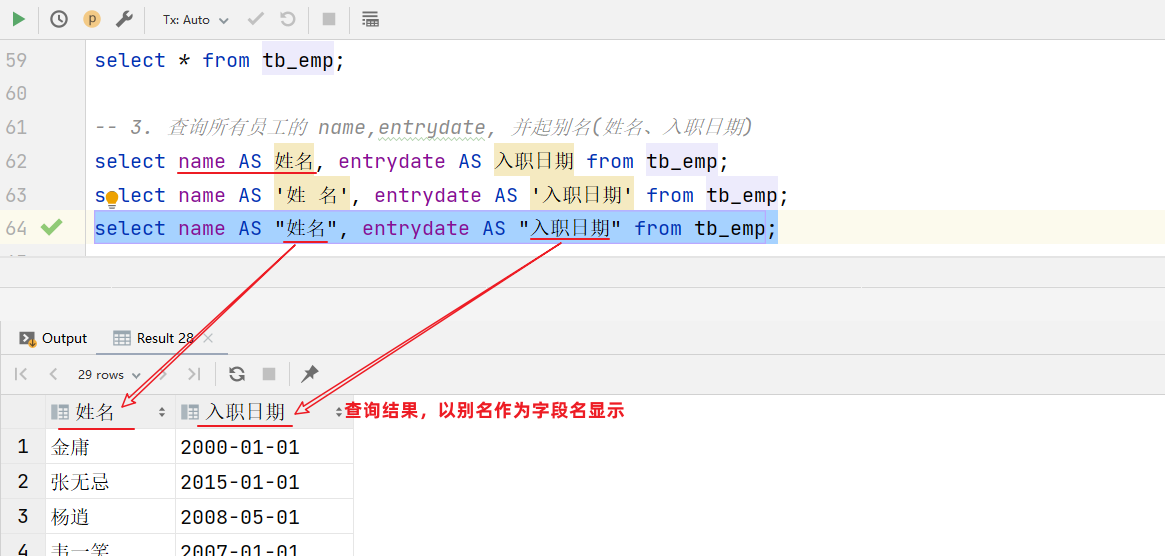
案例4:查询已有的员工关联了哪几种职位(不要重复)
select distinct job from tb_emp;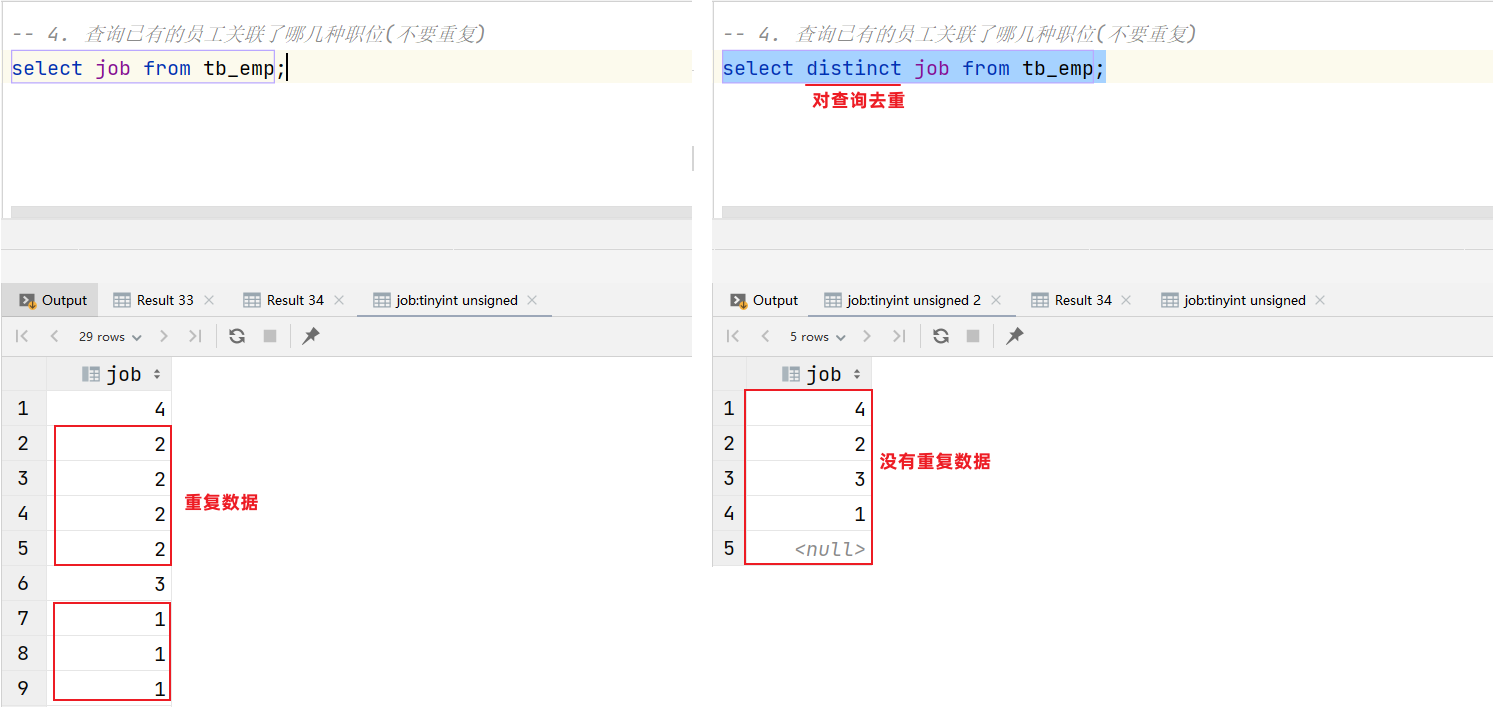
1.4 条件查询
语法:
select 字段列表 from 表名 where 条件列表 ; -- 条件列表:意味着可以有多个条件学习条件查询就是学习条件的构建方式,而在SQL语句当中构造条件的运算符分为两类:
- 比较运算符
- 逻辑运算符
常用的比较运算符如下:
| 比较运算符 | 功能 |
|---|---|
| > | 大于 |
| >= | 大于等于 |
| < | 小于 |
| <= | 小于等于 |
| = | 等于 |
| <> 或 != | 不等于 |
| between ... and ... | 在某个范围之内(含最小、最大值) |
| in(...) | 在in之后的列表中的值,多选一 |
| like 占位符 | 模糊匹配(_匹配单个字符, %匹配任意个字符) |
| is null | 是null |
常用的逻辑运算符如下:
| 逻辑运算符 | 功能 |
|---|---|
| and 或 && | 并且 (多个条件同时成立) |
| or 或 || | 或者 (多个条件任意一个成立) |
| not 或 ! | 非 , 不是 |
案例1:查询 姓名 为 杨逍 的员工
select id, username, password, name, gender, image, job, entrydate, create_time, update_time
from tb_emp
where name = '杨逍'; -- 字符串使用''或""包含
案例2:查询 id小于等于5 的员工信息
select id, username, password, name, gender, image, job, entrydate, create_time, update_time
from tb_emp
where id <=5;
案例3:查询 没有分配职位 的员工信息
select id, username, password, name, gender, image, job, entrydate, create_time, update_time
from tb_emp
where job is null ;
注意:查询为NULL的数据时,不能使用
= null
案例4:查询 有职位 的员工信息
select id, username, password, name, gender, image, job, entrydate, create_time, update_time
from tb_emp
where job is not null ;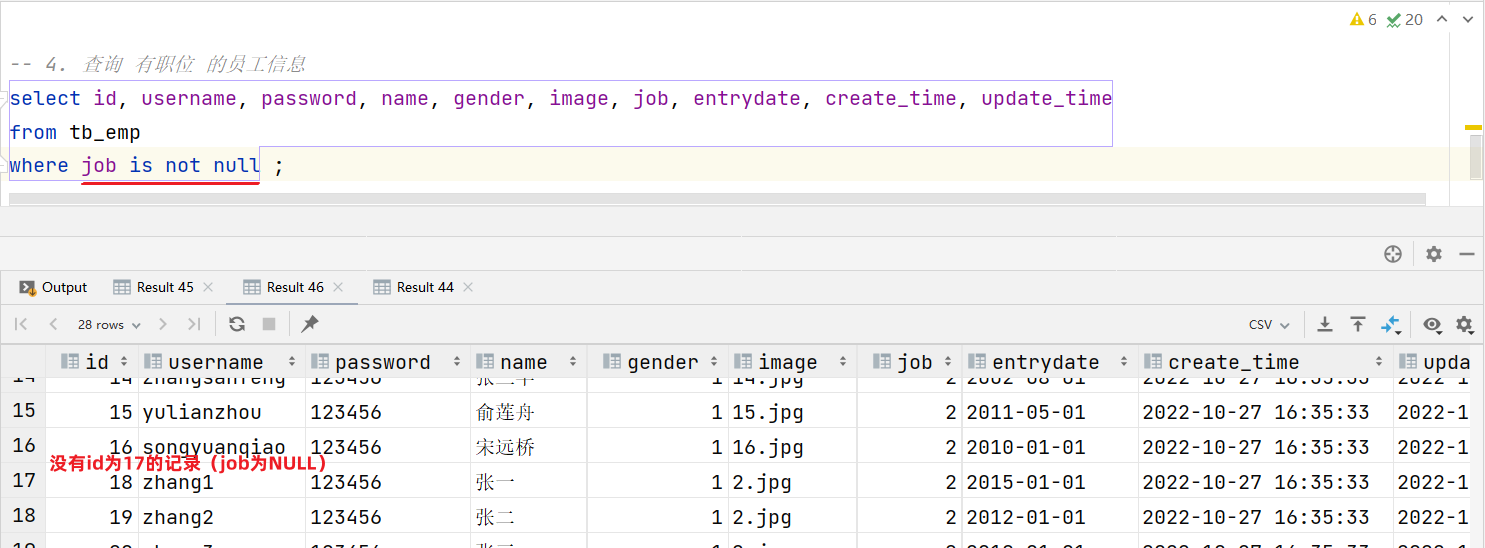
案例5:查询 密码不等于 '123456' 的员工信息
-- 方式1:
select id, username, password, name, gender, image, job, entrydate, create_time, update_time
from tb_emp
where password <> '123456';
-- 方式2:
select id, username, password, name, gender, image, job, entrydate, create_time, update_time
from tb_emp
where password != '123456';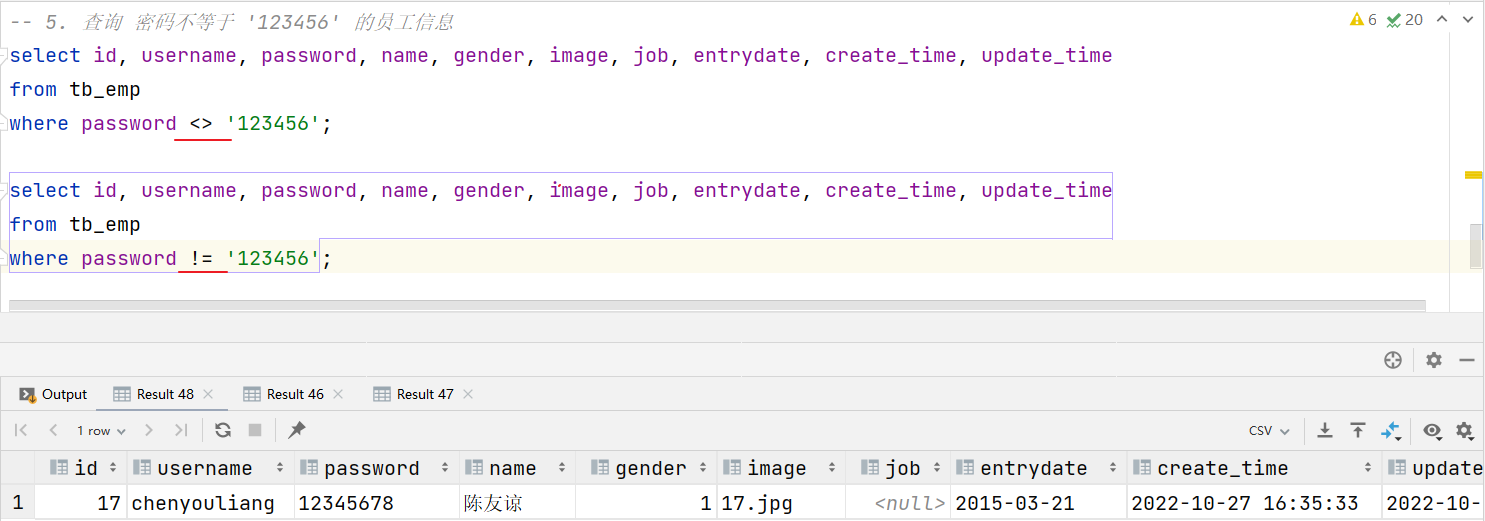
案例6:查询 入职日期 在 '2000-01-01' (包含) 到 '2010-01-01'(包含) 之间的员工信息
-- 方式1:
select id, username, password, name, gender, image, job, entrydate, create_time, update_time
from tb_emp
where entrydate>='2000-01-01' and entrydate<='2010-01-01';
-- 方式2: between...and
select id, username, password, name, gender, image, job, entrydate, create_time, update_time
from tb_emp
where entrydate between '2000-01-01' and '2010-01-01';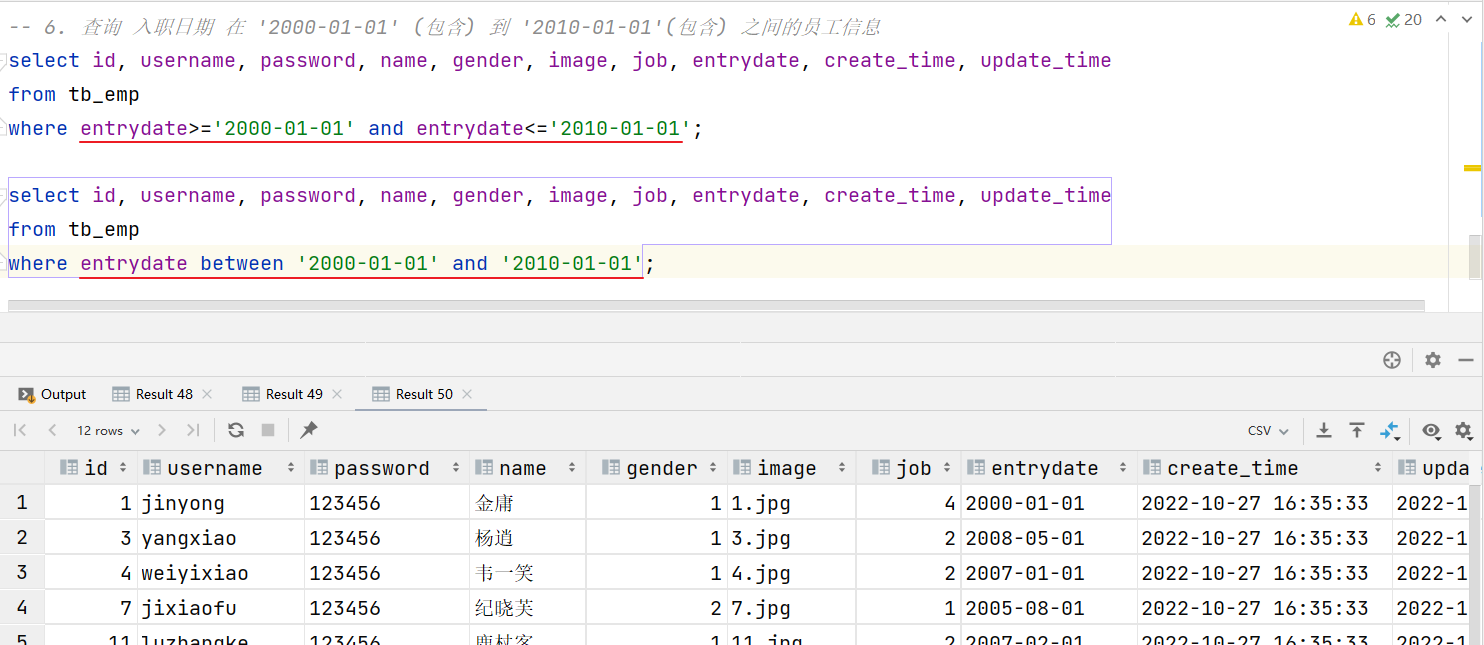
案例7:查询 入职时间 在 '2000-01-01' (包含) 到 '2010-01-01'(包含) 之间 且 性别为女 的员工信息
select id, username, password, name, gender, image, job, entrydate, create_time, update_time
from tb_emp
where entrydate between '2000-01-01' and '2010-01-01'
and gender = 2;
案例8:查询 职位是 2 (讲师), 3 (学工主管), 4 (教研主管) 的员工信息
-- 方式1:使用or连接多个条件
select id, username, password, name, gender, image, job, entrydate, create_time, update_time
from tb_emp
where job=2 or job=3 or job=4;
-- 方式2:in关键字
select id, username, password, name, gender, image, job, entrydate, create_time, update_time
from tb_emp
where job in (2,3,4);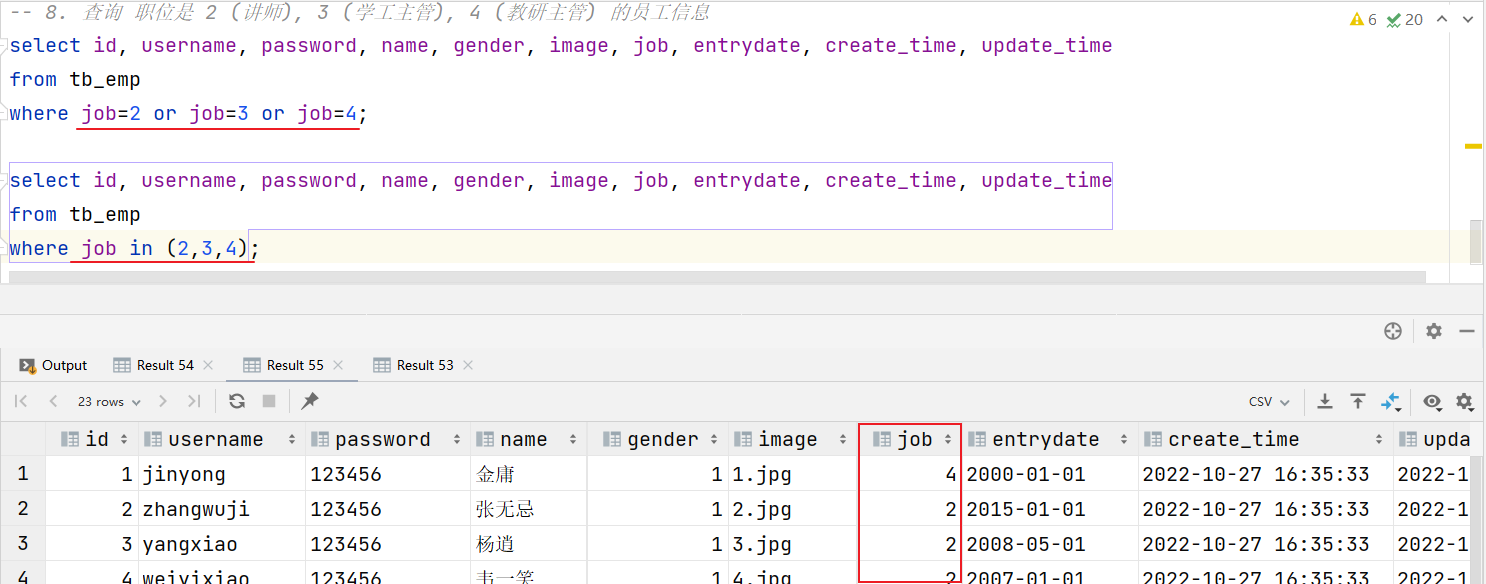
案例9:查询 姓名 为两个字的员工信息
select id, username, password, name, gender, image, job, entrydate, create_time, update_time
from tb_emp
where name like '__'; # 通配符 "_" 代表任意1个字符
案例10:查询 姓 '张' 的员工信息
select id, username, password, name, gender, image, job, entrydate, create_time, update_time
from tb_emp
where name like '张%'; # 通配符 "%" 代表任意个字符(0个 ~ 多个)
1.5 聚合函数
之前我们做的查询都是横向查询,就是根据条件一行一行的进行判断,而使用聚合函数查询就是纵向查询,它是对一列的值进行计算,然后返回一个结果值。(将一列数据作为一个整体,进行纵向计算)
语法:
select 聚合函数(字段列表) from 表名 ;注意 : 聚合函数会忽略空值,对NULL值不作为统计。
常用聚合函数:
| 函数 | 功能 |
|---|---|
| count | 统计数量 |
| max | 最大值 |
| min | 最小值 |
| avg | 平均值 |
| sum | 求和 |
count :按照列去统计有多少行数据。
- 在根据指定的列统计的时候,如果这一列中有null的行,该行不会被统计在其中。
sum :计算指定列的数值和,如果不是数值类型,那么计算结果为0
max :计算指定列的最大值
min :计算指定列的最小值
avg :计算指定列的平均值
案例1:统计该企业员工数量
# count(字段)
select count(id) from tb_emp;-- 结果:29
select count(job) from tb_emp;-- 结果:28 (聚合函数对NULL值不做计算)
# count(常量)
select count(0) from tb_emp;
select count('A') from tb_emp;
# count(*) 推荐此写法(MySQL底层进行了优化)
select count(*) from tb_emp;案例2:统计该企业最早入职的员工
select min(entrydate) from tb_emp;
案例3:统计该企业最迟入职的员工
select max(entrydate) from tb_emp;
案例4:统计该企业员工 ID 的平均值
select avg(id) from tb_emp;
案例5:统计该企业员工的 ID 之和
select sum(id) from tb_emp;
1.6 分组查询
分组: 按照某一列或者某几列,把相同的数据进行合并输出。
分组其实就是按列进行分类(指定列下相同的数据归为一类),然后可以对分类完的数据进行合并计算。
分组查询通常会使用聚合函数进行计算。
语法:
select 字段列表 from 表名 [where 条件] group by 分组字段名 [having 分组后过滤条件];案例1:根据性别分组 , 统计男性和女性员工的数量
select gender, count(*)
from tb_emp
group by gender; -- 按照gender字段进行分组(gender字段下相同的数据归为一组)
案例2:查询入职时间在 '2015-01-01' (包含) 以前的员工 , 并对结果根据职位分组 , 获取员工数量大于等于2的职位
select job, count(*)
from tb_emp
where entrydate <= '2015-01-01' -- 分组前条件
group by job -- 按照job字段分组
having count(*) >= 2; -- 分组后条件
注意事项:
• 分组之后,查询的字段一般为聚合函数和分组字段,查询其他字段无任何意义
• 执行顺序:where > 聚合函数 > having
where与having区别(面试题)
- 执行时机不同:where是分组之前进行过滤,不满足where条件,不参与分组;而having是分组之后对结果进行过滤。
- 判断条件不同:where不能对聚合函数进行判断,而having可以。
1.7 排序查询
排序在日常开发中是非常常见的一个操作,有升序排序,也有降序排序。
语法:
select 字段列表
from 表名
[where 条件列表]
[group by 分组字段 ]
order by 字段1 排序方式1 , 字段2 排序方式2 … ;-
排序方式:
-
ASC :升序(默认值)
-
DESC:降序
-
案例1:根据入职时间, 对员工进行升序排序
select id, username, password, name, gender, image, job, entrydate, create_time, update_time
from tb_emp
order by entrydate ASC; -- 按照entrydate字段下的数据进行升序排序
select id, username, password, name, gender, image, job, entrydate, create_time, update_time
from tb_emp
order by entrydate; -- 默认就是ASC(升序)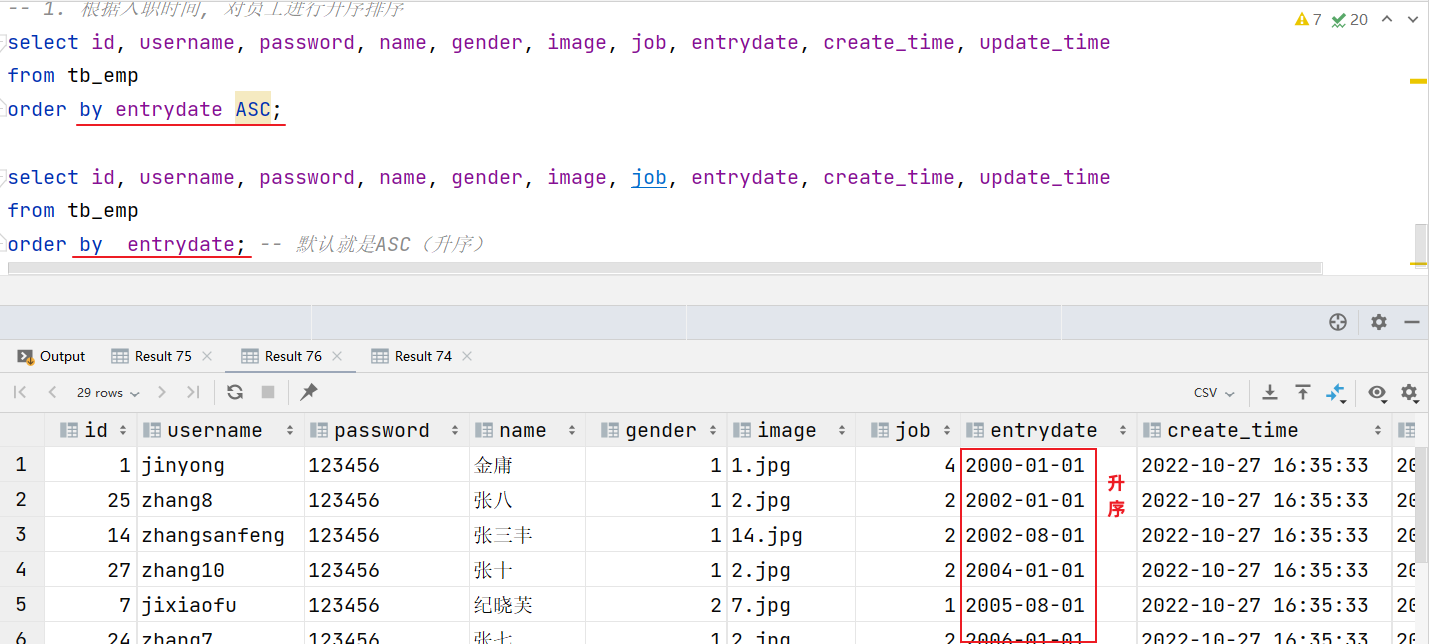
注意事项:如果是升序, 可以不指定排序方式ASC
案例2:根据入职时间,对员工进行降序排序
select id, username, password, name, gender, image, job, entrydate, create_time, update_time
from tb_emp
order by entrydate DESC; -- 按照entrydate字段下的数据进行降序排序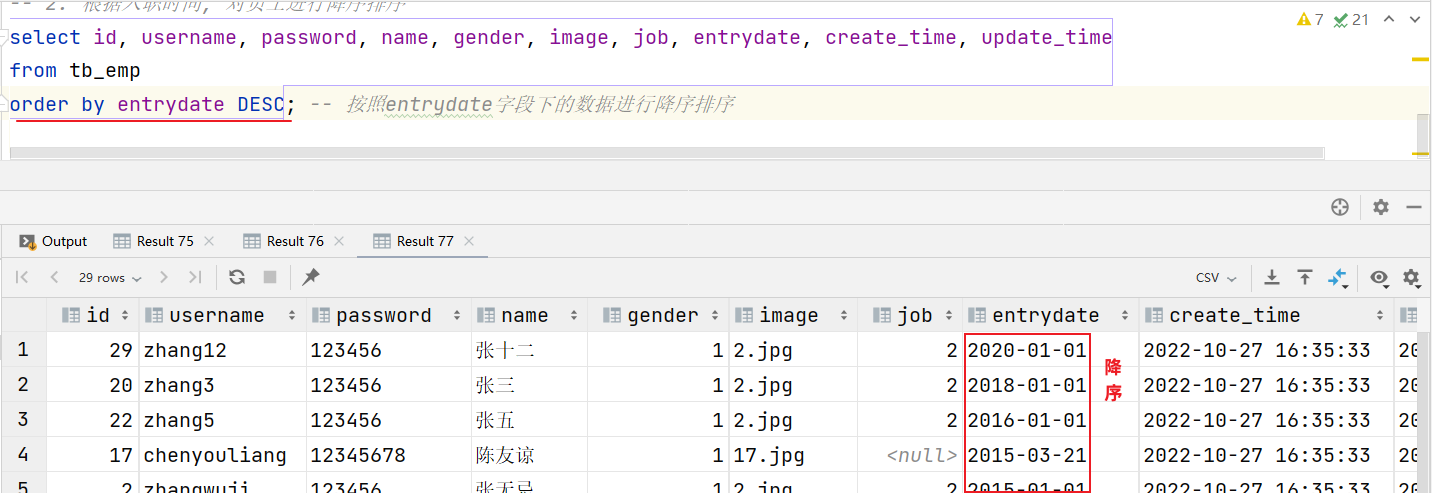
案例3:根据入职时间对公司的员工进行升序排序,入职时间相同,再按照更新时间进行降序排序
select id, username, password, name, gender, image, job, entrydate, create_time, update_time
from tb_emp
order by entrydate ASC , update_time DESC;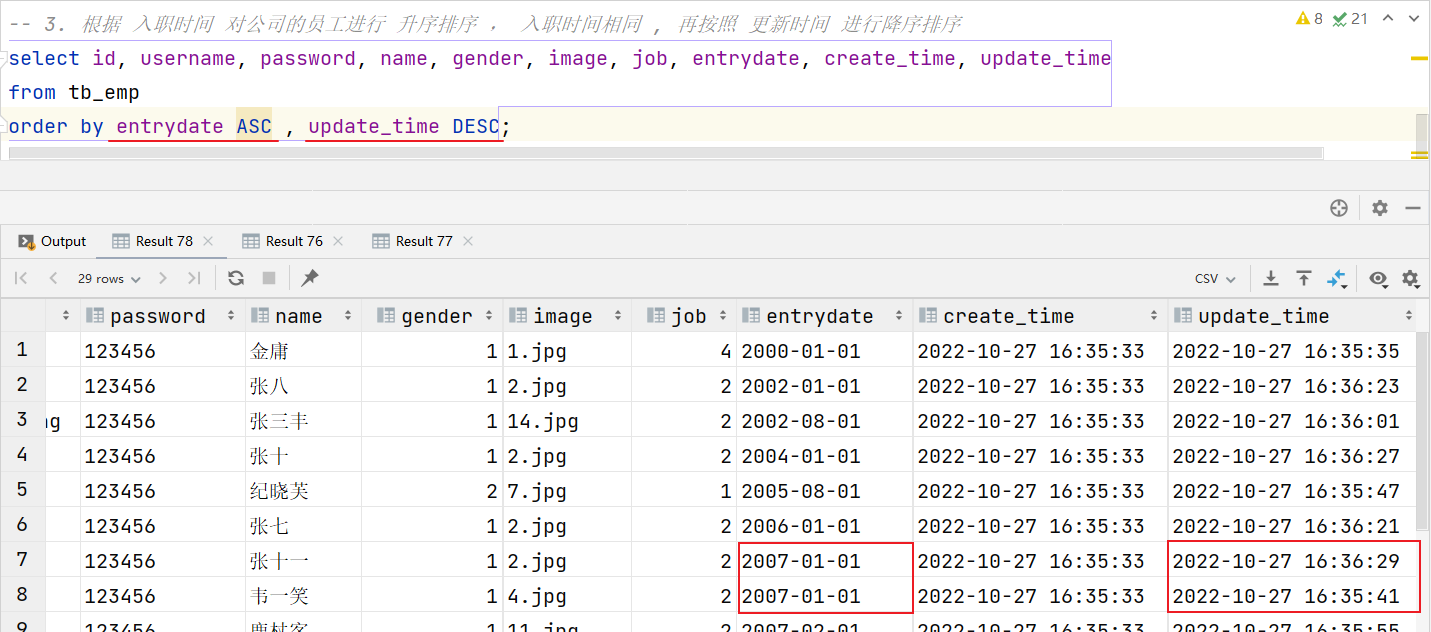
注意事项:如果是多字段排序,当第一个字段值相同时,才会根据第二个字段进行排序
1.8 分页查询
分页操作在业务系统开发时,也是非常常见的一个功能,日常我们在网站中看到的各种各样的分页条,后台也都需要借助于数据库的分页操作。

分页查询语法:
select 字段列表 from 表名 limit 起始索引, 查询记录数 ;案例1:从起始索引0开始查询员工数据, 每页展示5条记录
select id, username, password, name, gender, image, job, entrydate, create_time, update_time
from tb_emp
limit 0 , 5; -- 从索引0开始,向后取5条记录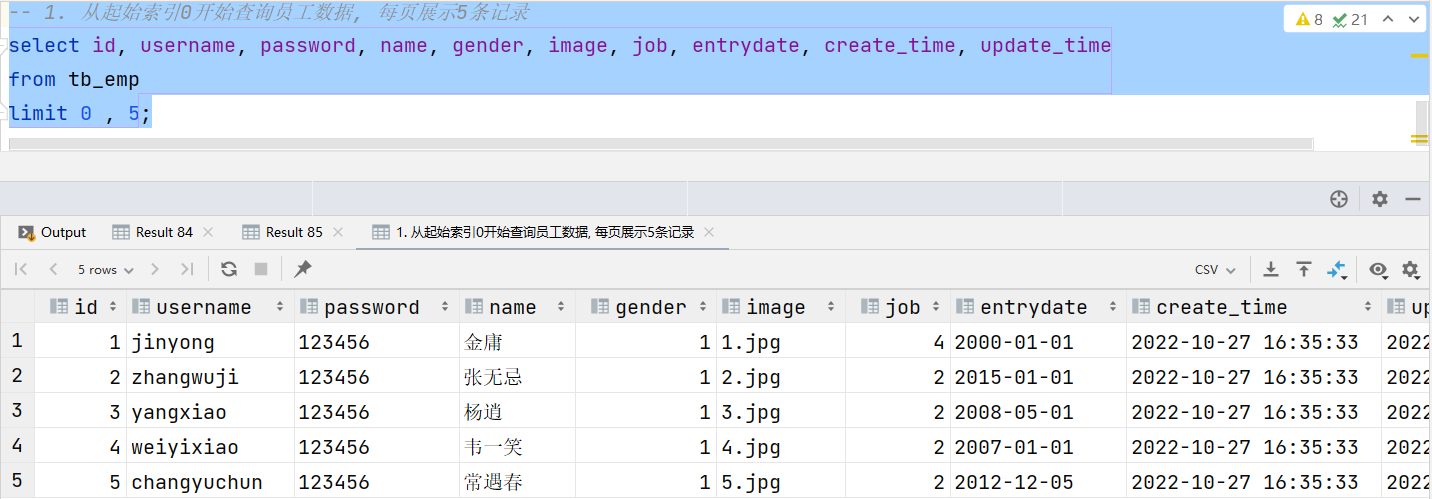
案例2:查询 第1页 员工数据, 每页展示5条记录
select id, username, password, name, gender, image, job, entrydate, create_time, update_time
from tb_emp
limit 5; -- 如果查询的是第1页数据,起始索引可以省略,直接简写为:limit 条数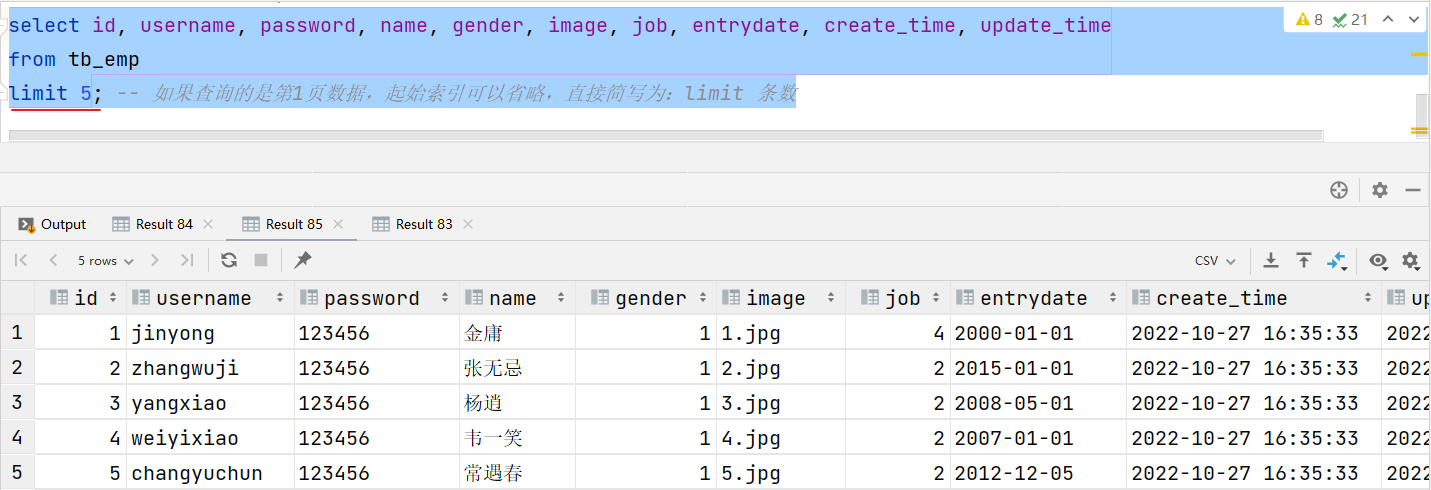
案例3:查询 第2页 员工数据, 每页展示5条记录
select id, username, password, name, gender, image, job, entrydate, create_time, update_time
from tb_emp
limit 5 , 5; -- 从索引5开始,向后取5条记录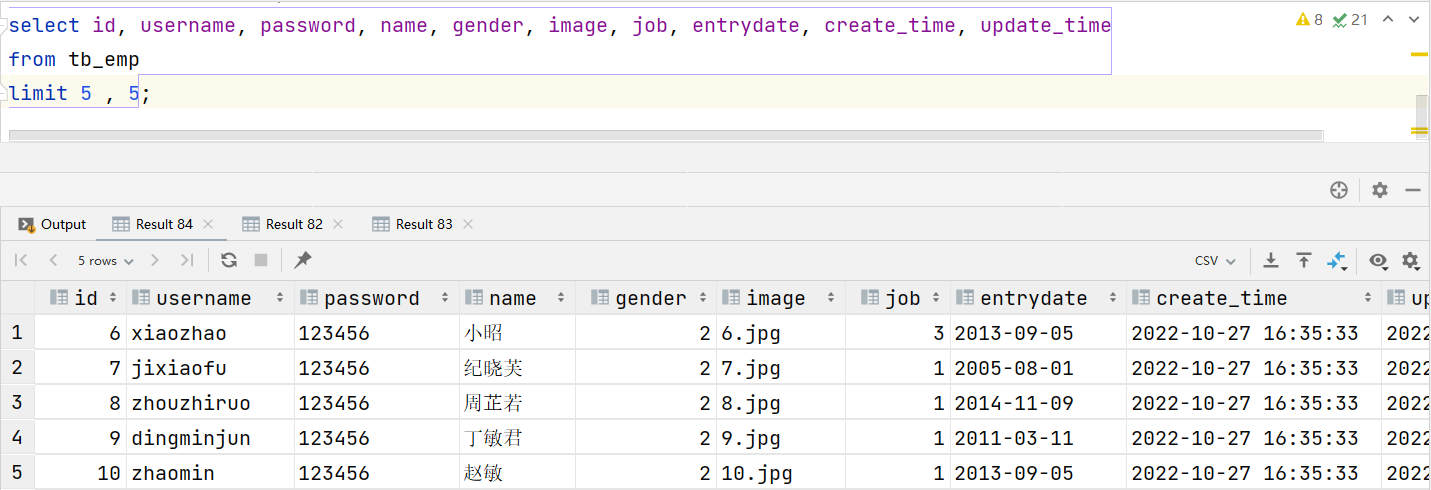
案例4:查询 第3页 员工数据, 每页展示5条记录
select id, username, password, name, gender, image, job, entrydate, create_time, update_time
from tb_emp
limit 10 , 5; -- 从索引10开始,向后取5条记录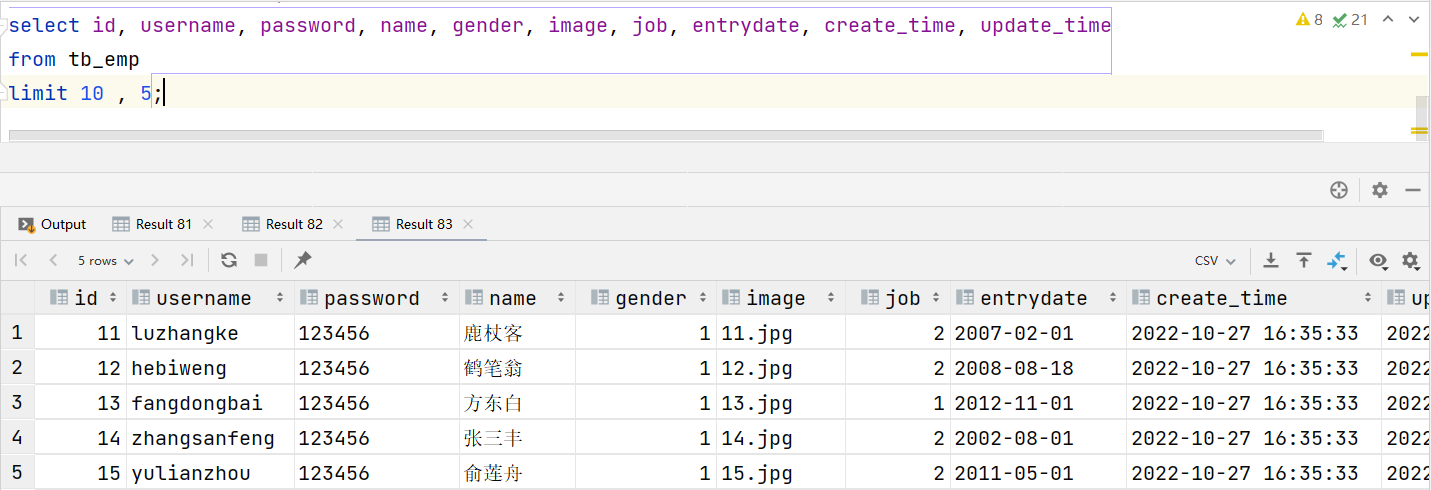
注意事项:
起始索引从0开始。 计算公式 : 起始索引 = (查询页码 - 1)* 每页显示记录数
分页查询是数据库的方言,不同的数据库有不同的实现,MySQL中是LIMIT
如果查询的是第一页数据,起始索引可以省略,直接简写为 limit 条数
1.9 案例
DQL的基本语法我们学习结束了,接下来我们就运用所掌握的DQL语句的语法来完成两个案例。
1.9.1 案例一
案例:根据需求完成员工管理的条件分页查询
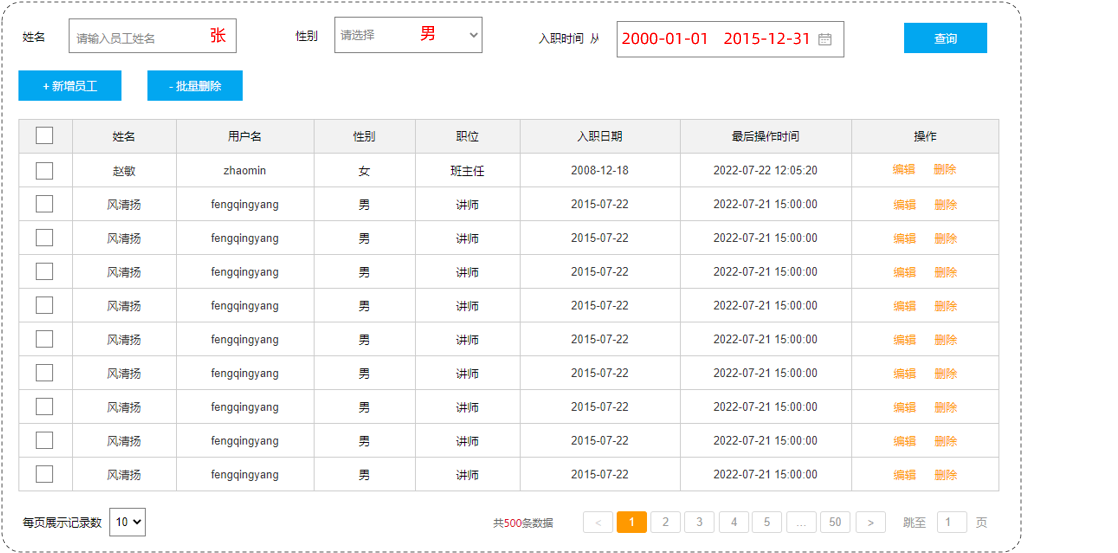
分析:根据输入的条件,查询第1页数据
在员工管理的列表上方有一些查询条件:员工姓名、员工性别,员工入职时间(开始时间~结束时间)
- 姓名:张
- 性别:男
- 入职时间:2000-01-01 ~ 2015-12-31
除了查询条件外,在列表的下面还有一个分页条,这就涉及到了分页查询
- 查询第1页数据(每页显示10条数据)
基于查询的结果,按照修改时间进行降序排序
结论:条件查询 + 分页查询 + 排序查询
SQL语句代码:
-- 根据输入条件查询第1页数据(每页展示10条记录)
-- 输入条件:
-- 姓名:张 (模糊查询)
-- 性别:男
-- 入职时间:2000-01-01 ~ 2015-12-31
-- 分页: 0 , 10
-- 排序: 修改时间 DESC
select id, username, password, name, gender, image, job, entrydate, create_time, update_time
from tb_emp
where name like '张%' and gender = 1 and entrydate between '2000-01-01' and '2015-12-31'
order by update_time desc
limit 0 , 10;
1.9.2 案例二
案例:根据需求完成员工信息的统计
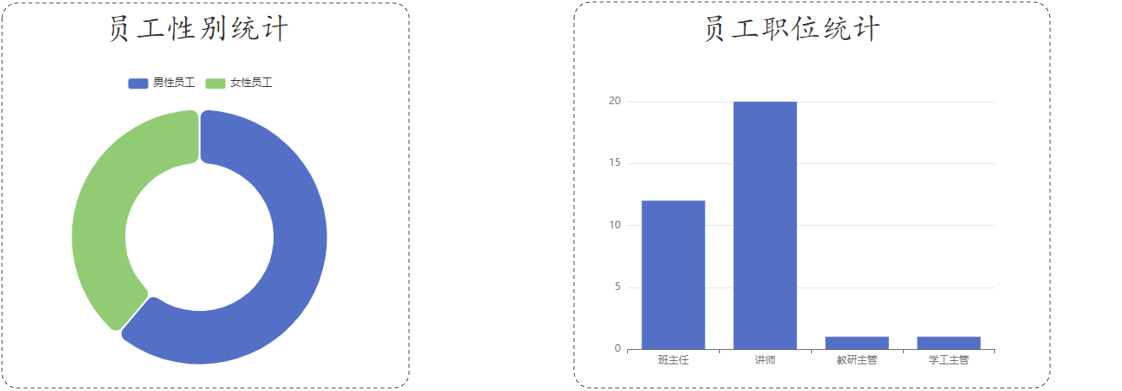
分析:以上信息统计在开发中也叫图形报表(将统计好的数据以可视化的形式展示出来)
- 员工性别统计:以饼状图的形式展示出企业男性员人数和女性员工人数
- 只要查询出男性员工和女性员工各自有多少人就可以了
- 员工职位统计:以柱状图的形式展示各职位的在岗人数
- 只要查询出各个职位有多少人就可以了
员工性别统计:
-- if(条件表达式, true取值 , false取值)
select if(gender=1,'男性员工','女性员工') AS 性别, count(*) AS 人数
from tb_emp
group by gender;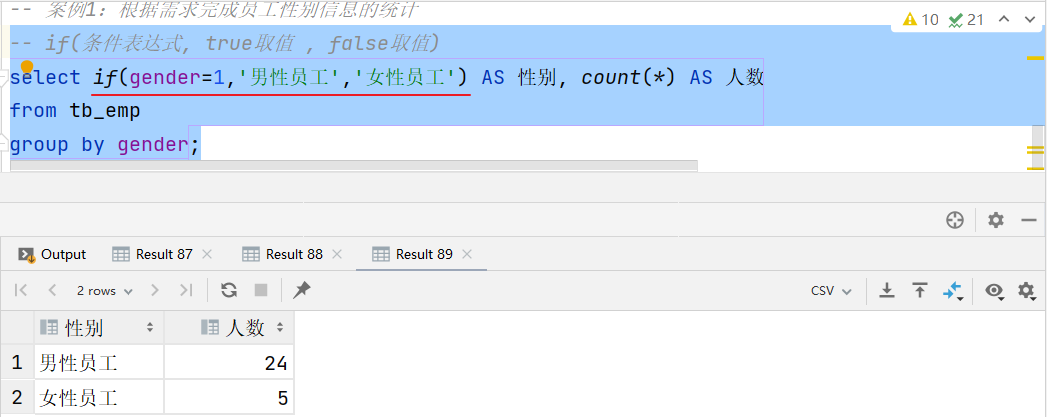
if(表达式, tvalue, fvalue) :当表达式为true时,取值tvalue;当表达式为false时,取值fvalue
员工职位统计:
-- case 表达式 when 值1 then 结果1 when 值2 then 结果2 ... else result end
select (case job
when 1 then '班主任'
when 2 then '讲师'
when 3 then '学工主管'
when 4 then '教研主管'
else '未分配职位'
end) AS 职位 ,
count(*) AS 人数
from tb_emp
group by job;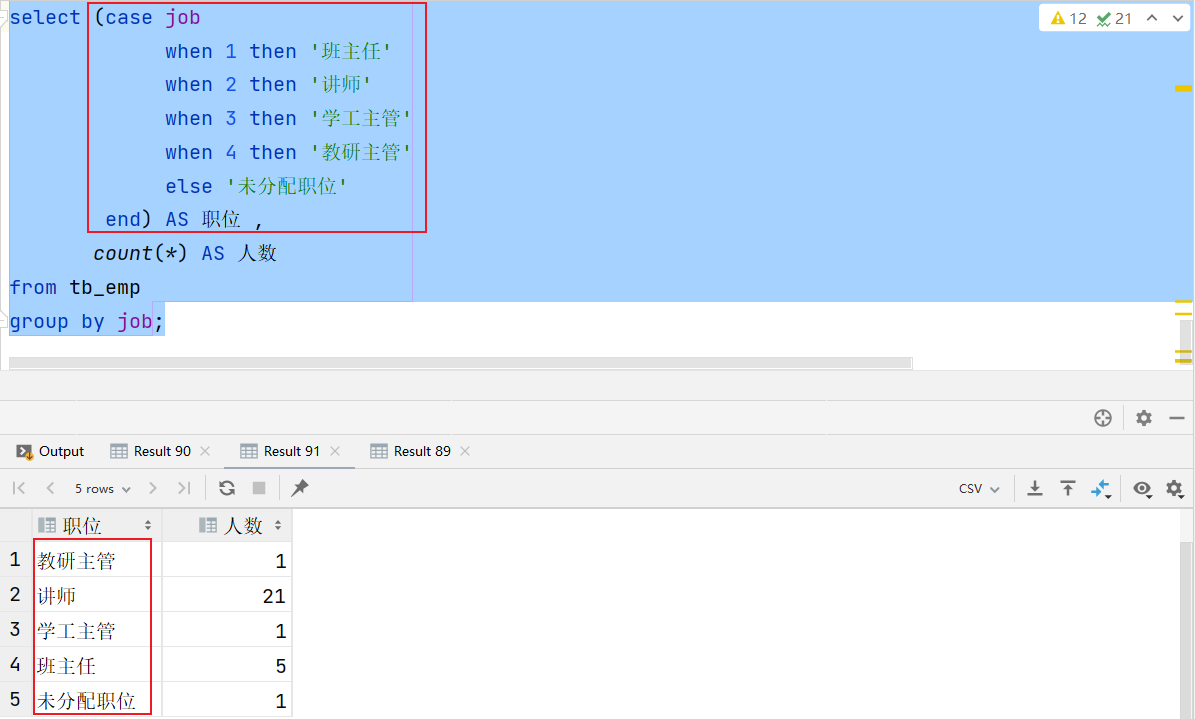
case 表达式 when 值1 then 结果1 [when 值2 then 结果2 ...] [else result] end
2. 多表设计
关于单表的操作(单表的设计、单表的增删改查)我们就已经学习完了。接下来我们就要来学习多表的操作,首先来学习多表的设计。
项目开发中,在进行数据库表结构设计时,会根据业务需求及业务模块之间的关系,分析并设计表结构,由于业务之间相互关联,所以各个表结构之间也存在着各种联系,基本上分为三种:
-
一对多(多对一)
-
多对多
-
一对一
2.1 一对多
2.1.1 表设计
需求:根据页面原型及需求文档 ,完成部门及员工的表结构设计
- 员工管理页面原型:(前面已完成tb_emp表结构设计)
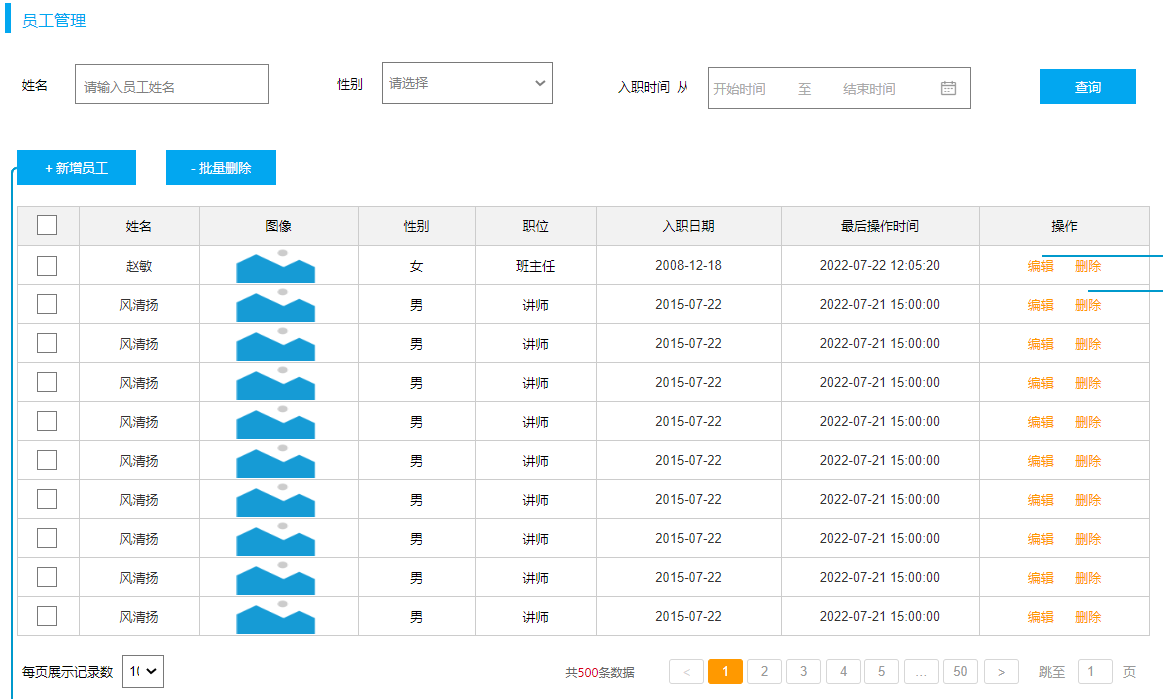
- 部门管理页面原型:
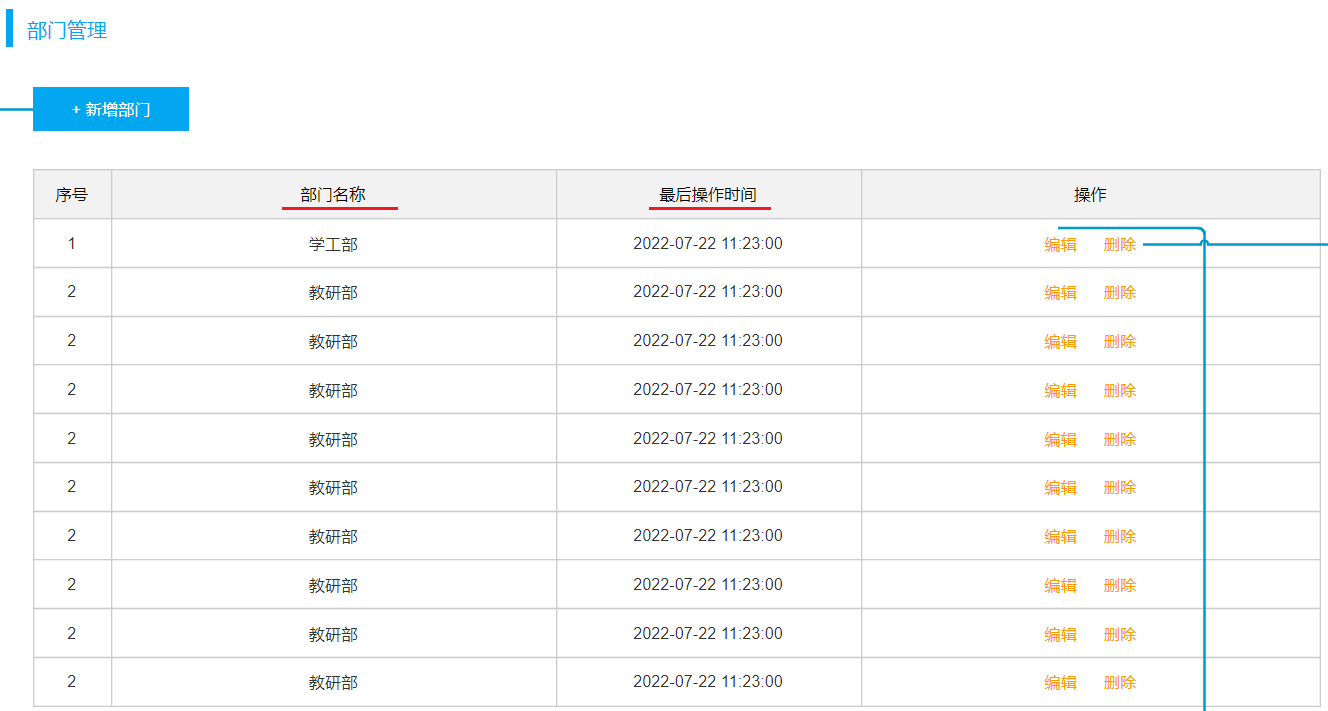

经过上述分析,现已明确的部门表结构:
- 业务字段 : 部门名称
- 基础字段 : id(主键)、创建时间、修改时间
部门表 - SQL语句:
# 建议:创建新的数据库(多表设计存放在新数据库下)
create database db03;
use db03;
-- 部门表
create table tb_dept
(
id int unsigned primary key auto_increment comment '主键ID',
name varchar(10) not null unique comment '部门名称',
create_time datetime not null comment '创建时间',
update_time datetime not null comment '修改时间'
) comment '部门表';部门表创建好之后,我们还需要再修改下员工表。为什么要修改员工表呢?是因为我们之前设计员工表(单表)的时候,并没有考虑员工的归属部门。
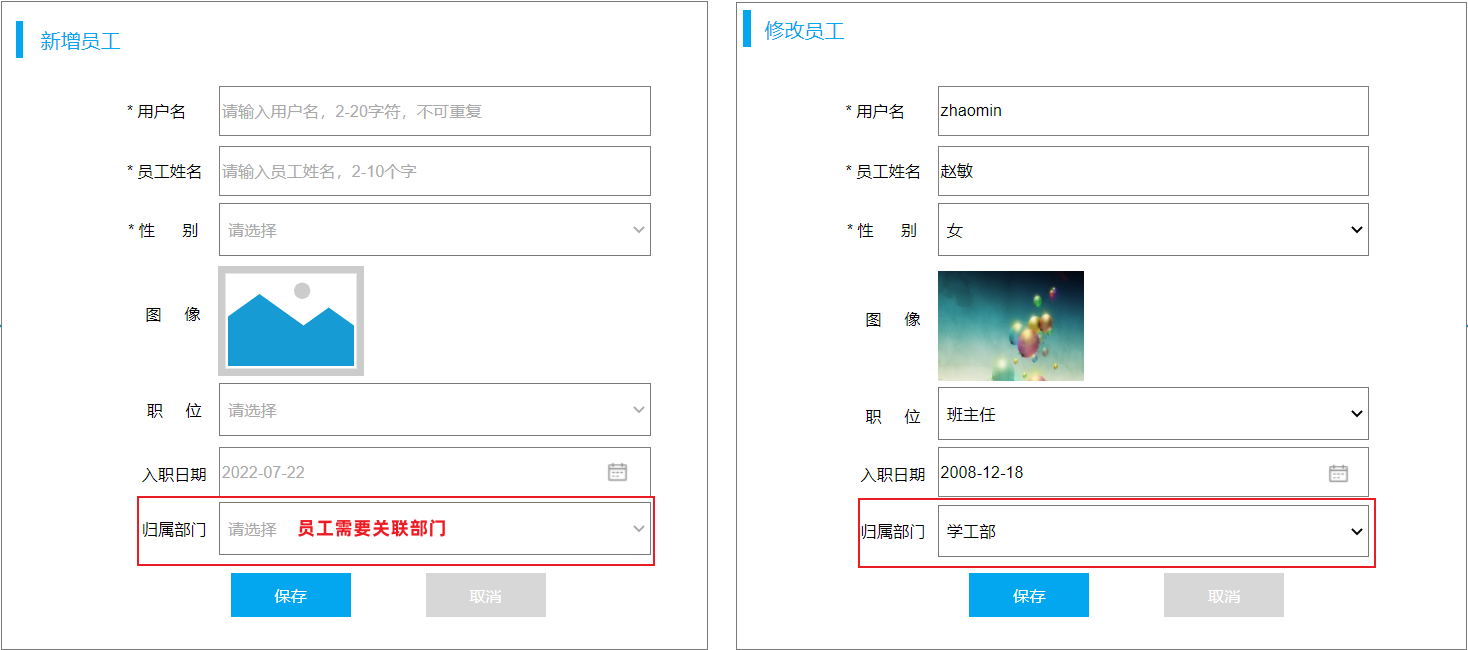
员工表:添加归属部门字段
-- 员工表
create table tb_emp
(
id int unsigned primary key auto_increment comment 'ID',
username varchar(20) not null unique comment '用户名',
password varchar(32) default '123456' comment '密码',
name varchar(10) not null comment '姓名',
gender tinyint unsigned not null comment '性别, 说明: 1 男, 2 女',
image varchar(300) comment '图像',
job tinyint unsigned comment '职位, 说明: 1 班主任,2 讲师, 3 学工主管, 4 教研主管',
entrydate date comment '入职时间',
dept_id int unsigned comment '部门ID', -- 员工的归属部门
create_time datetime not null comment '创建时间',
update_time datetime not null comment '修改时间'
) comment '员工表';测试数据:
-- 部门表测试数据
insert into tb_dept (id, name, create_time, update_time) values
(1,'学工部',now(),now()),
(2,'教研部',now(),now()),
(3,'咨询部',now(),now()),
(4,'就业部',now(),now()),
(5,'人事部',now(),now());
-- 员工表测试数据
INSERT INTO tb_emp
(id, username, password, name, gender, image, job, entrydate,dept_id, create_time, update_time) VALUES
(1,'jinyong','123456','金庸',1,'1.jpg',4,'2000-01-01',2,now(),now()),
(2,'zhangwuji','123456','张无忌',1,'2.jpg',2,'2015-01-01',2,now(),now()),
(3,'yangxiao','123456','杨逍',1,'3.jpg',2,'2008-05-01',2,now(),now()),
(4,'weiyixiao','123456','韦一笑',1,'4.jpg',2,'2007-01-01',2,now(),now()),
(5,'changyuchun','123456','常遇春',1,'5.jpg',2,'2012-12-05',2,now(),now()),
(6,'xiaozhao','123456','小昭',2,'6.jpg',3,'2013-09-05',1,now(),now()),
(7,'jixiaofu','123456','纪晓芙',2,'7.jpg',1,'2005-08-01',1,now(),now()),
(8,'zhouzhiruo','123456','周芷若',2,'8.jpg',1,'2014-11-09',1,now(),now()),
(9,'dingminjun','123456','丁敏君',2,'9.jpg',1,'2011-03-11',1,now(),now()),
(10,'zhaomin','123456','赵敏',2,'10.jpg',1,'2013-09-05',1,now(),now()),
(11,'luzhangke','123456','鹿杖客',1,'11.jpg',1,'2007-02-01',1,now(),now()),
(12,'hebiweng','123456','鹤笔翁',1,'12.jpg',1,'2008-08-18',1,now(),now()),
(13,'fangdongbai','123456','方东白',1,'13.jpg',2,'2012-11-01',2,now(),now()),
(14,'zhangsanfeng','123456','张三丰',1,'14.jpg',2,'2002-08-01',2,now(),now()),
(15,'yulianzhou','123456','俞莲舟',1,'15.jpg',2,'2011-05-01',2,now(),now()),
(16,'songyuanqiao','123456','宋远桥',1,'16.jpg',2,'2010-01-01',2,now(),now()),
(17,'chenyouliang','123456','陈友谅',1,'17.jpg',NULL,'2015-03-21',NULL,now(),now());员工表 - 部门表之间的关系:

一对多关系实现:在数据库表中多的一方,添加字段,来关联属于一这方的主键。
2.1.2 外键约束
问题
- 表结构创建完毕后,我们看到两张表的数据分别为:

现在员工表中有五个员工都归属于1号部门(学工部),当删除了1号部门后,数据变为:
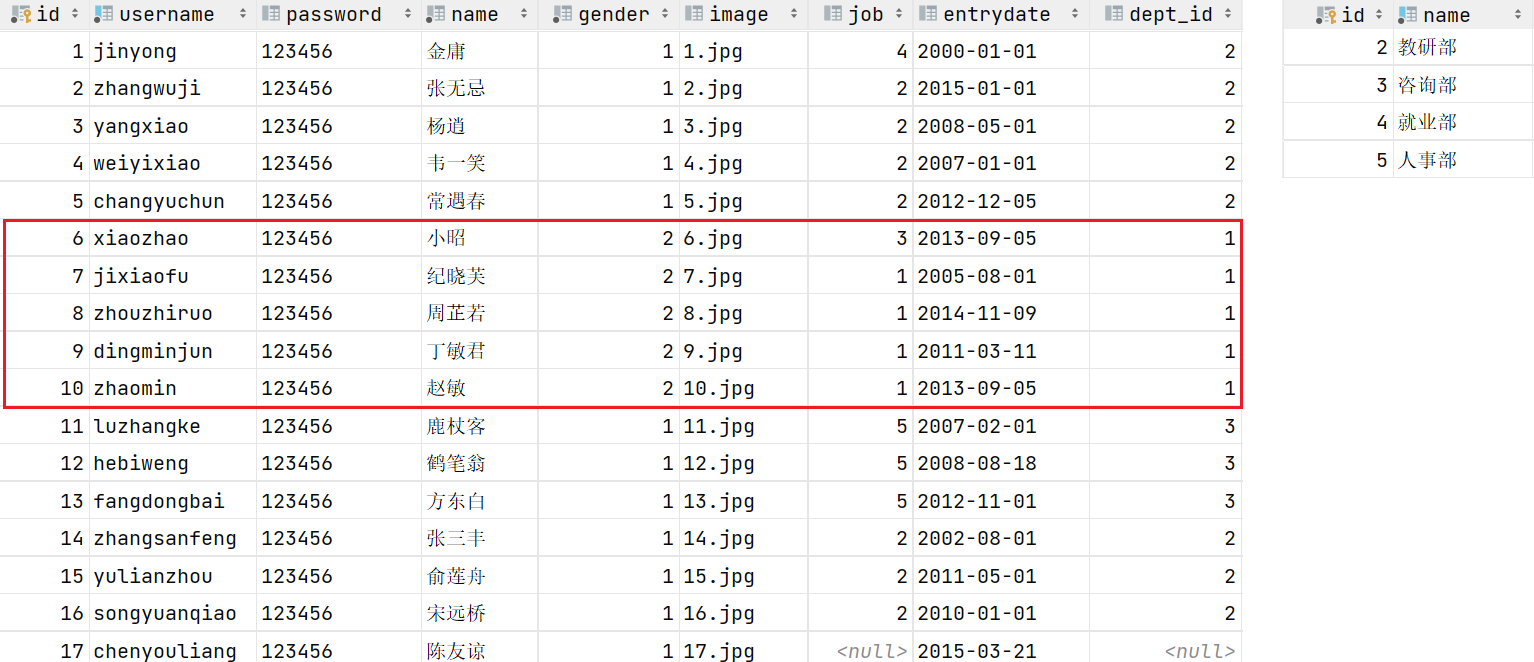
1号部门被删除了,但是依然还有5个员工是属于1号部门的。 此时:就出现数据的不完整、不一致了。
问题分析
目前上述的两张表(员工表、部门表),在数据库层面,并未建立关联,所以是无法保证数据的一致性和完整性的
问题解决
想解决上述的问题呢,我们就可以通过数据库中的 外键约束 来解决。
外键约束:让两张表的数据建立连接,保证数据的一致性和完整性。
对应的关键字:foreign key
外键约束的语法:
-- 创建表时指定
create table 表名(
字段名 数据类型,
...
[constraint] [外键名称] foreign key (外键字段名) references 主表 (主表列名)
);
-- 建完表后,添加外键
alter table 表名 add constraint 外键名称 foreign key(外键字段名) references 主表(主表列名);那接下来,我们就为员工表的dept_id 建立外键约束,来关联部门表的主键。
方式1:通过SQL语句操作
-- 修改表: 添加外键约束
alter table tb_emp
add constraint fk_dept_id foreign key (dept_id) references tb_dept(id);方式2:图形化界面操作
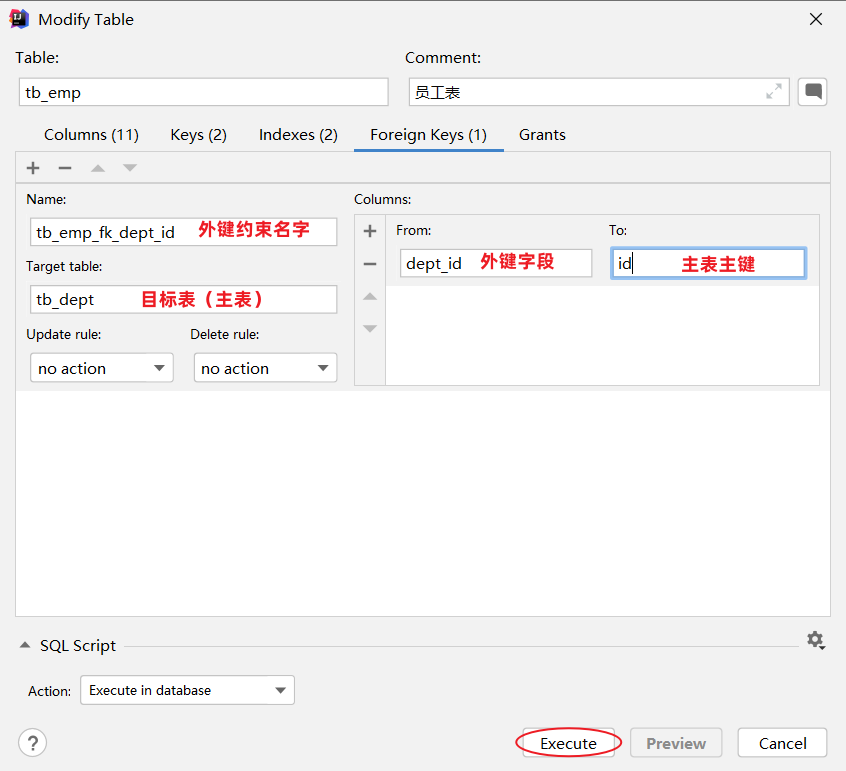
当我们添加外键约束时,我们得保证当前数据库表中的数据是完整的。 所以,我们需要将之前删除掉的数据再添加回来。
当我们添加了外键之后,再删除ID为1的部门,就会发现,此时数据库报错了,不允许删除。
外键约束(foreign key):保证了数据的完整性和一致性。
物理外键和逻辑外键
-
物理外键
- 概念:使用foreign key定义外键关联另外一张表。
- 缺点:
- 影响增、删、改的效率(需要检查外键关系)。
- 仅用于单节点数据库,不适用与分布式、集群场景。
- 容易引发数据库的死锁问题,消耗性能。
-
逻辑外键
- 概念:在业务层逻辑中,解决外键关联。
- 通过逻辑外键,就可以很方便的解决上述问题。
在现在的企业开发中,很少会使用物理外键,都是使用逻辑外键。 甚至在一些数据库开发规范中,会明确指出禁止使用物理外键 foreign key
2.2 一对一
一对一关系表在实际开发中应用起来比较简单,通常是用来做单表的拆分,也就是将一张大表拆分成两张小表,将大表中的一些基础字段放在一张表当中,将其他的字段放在另外一张表当中,以此来提高数据的操作效率。
一对一的应用场景: 用户表(基本信息+身份信息)
- 基本信息:用户的ID、姓名、性别、手机号、学历
- 身份信息:民族、生日、身份证号、身份证签发机关,身份证的有效期(开始时间、结束时间)
如果在业务系统当中,对用户的基本信息查询频率特别的高,但是对于用户的身份信息查询频率很低,此时出于提高查询效率的考虑,我就可以将这张大表拆分成两张小表,第一张表存放的是用户的基本信息,而第二张表存放的就是用户的身份信息。他们两者之间一对一的关系,一个用户只能对应一个身份证,而一个身份证也只能关联一个用户。
那么在数据库层面怎么去体现上述两者之间是一对一的关系呢?
其实一对一我们可以看成一种特殊的一对多。一对多我们是怎么设计表关系的?是不是在多的一方添加外键。同样我们也可以通过外键来体现一对一之间的关系,我们只需要在任意一方来添加一个外键就可以了。

一对一 :在任意一方加入外键,关联另外一方的主键,并且设置外键为唯一的(UNIQUE)
SQL脚本:
-- 用户基本信息表
create table tb_user(
id int unsigned primary key auto_increment comment 'ID',
name varchar(10) not null comment '姓名',
gender tinyint unsigned not null comment '性别, 1 男 2 女',
phone char(11) comment '手机号',
degree varchar(10) comment '学历'
) comment '用户基本信息表';
-- 测试数据
insert into tb_user values (1,'白眉鹰王',1,'18812340001','初中'),
(2,'青翼蝠王',1,'18812340002','大专'),
(3,'金毛狮王',1,'18812340003','初中'),
(4,'紫衫龙王',2,'18812340004','硕士');
-- 用户身份信息表
create table tb_user_card(
id int unsigned primary key auto_increment comment 'ID',
nationality varchar(10) not null comment '民族',
birthday date not null comment '生日',
idcard char(18) not null comment '身份证号',
issued varchar(20) not null comment '签发机关',
expire_begin date not null comment '有效期限-开始',
expire_end date comment '有效期限-结束',
user_id int unsigned not null unique comment '用户ID',
constraint fk_user_id foreign key (user_id) references tb_user(id)
) comment '用户身份信息表';
-- 测试数据
insert into tb_user_card values (1,'汉','1960-11-06','100000100000100001','朝阳区公安局','2000-06-10',null,1),
(2,'汉','1971-11-06','100000100000100002','静安区公安局','2005-06-10','2025-06-10',2),
(3,'汉','1963-11-06','100000100000100003','昌平区公安局','2006-06-10',null,3),
(4,'回','1980-11-06','100000100000100004','海淀区公安局','2008-06-10','2028-06-10',4);2.3 多对多
多对多的关系在开发中属于也比较常见的。比如:学生和老师的关系,一个学生可以有多个授课老师,一个授课老师也可以有多个学生。在比如:学生和课程的关系,一个学生可以选修多门课程,一个课程也可以供多个学生选修。
案例:学生与课程的关系
-
关系:一个学生可以选修多门课程,一门课程也可以供多个学生选择
-
实现关系:建立第三张中间表,中间表至少包含两个外键,分别关联两方主键

SQL脚本:
-- 学生表
create table tb_student(
id int auto_increment primary key comment '主键ID',
name varchar(10) comment '姓名',
no varchar(10) comment '学号'
) comment '学生表';
-- 学生表测试数据
insert into tb_student(name, no) values ('黛绮丝', '2000100101'),('谢逊', '2000100102'),('殷天正', '2000100103'),('韦一笑', '2000100104');
-- 课程表
create table tb_course(
id int auto_increment primary key comment '主键ID',
name varchar(10) comment '课程名称'
) comment '课程表';
-- 课程表测试数据
insert into tb_course (name) values ('Java'), ('PHP'), ('MySQL') , ('Hadoop');
-- 学生课程表(中间表)
create table tb_student_course(
id int auto_increment comment '主键' primary key,
student_id int not null comment '学生ID',
course_id int not null comment '课程ID',
constraint fk_courseid foreign key (course_id) references tb_course (id),
constraint fk_studentid foreign key (student_id) references tb_student (id)
)comment '学生课程中间表';
-- 学生课程表测试数据
insert into tb_student_course(student_id, course_id) values (1,1),(1,2),(1,3),(2,2),(2,3),(3,4);2.4 案例
下面通过一个综合案例加深对于多表关系的理解,并掌握多表设计的流程。
需求
步骤
-
阅读页面原型及需求文档,分析各个模块涉及到的表结构,及表结构之间的关系。
-
根据页面原型及需求文档,分析各个表结构中具体的字段及约束。
分析
- 页面原型-分类管理
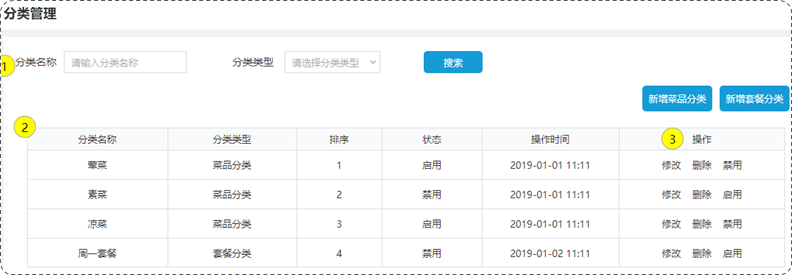
分类的信息:分类名称、分类类型[菜品/套餐]、分类排序、分类状态[禁用/启用]、分类的操作时间(修改时间)。
- 页面原型-菜品管理
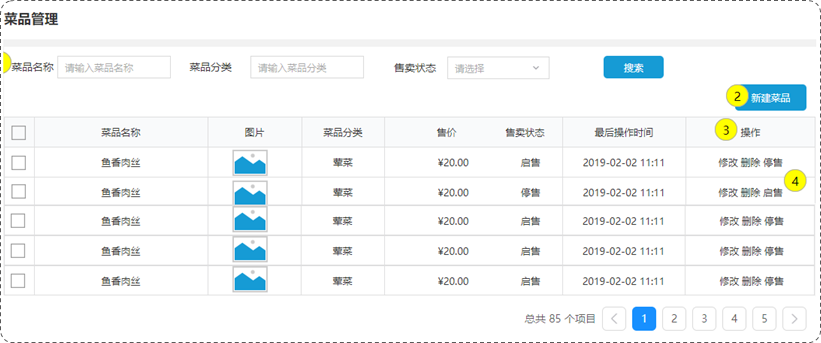
菜品的信息:菜品名称、菜品图片、菜品分类、菜品售价、菜品售卖状态、菜品的操作时间(修改时间)。
思考:分类与菜品之间是什么关系?
- 思考逻辑:一个分类下可以有多个菜品吗?反过来再想一想,一个菜品会对应多个分类吗?
答案:一对多关系。一个分类下会有多个菜品,而一个菜品只能归属一个分类。
设计表原则:在多的一方,添加字段,关联属于一这方的主键。
- 页面原型-套餐管理
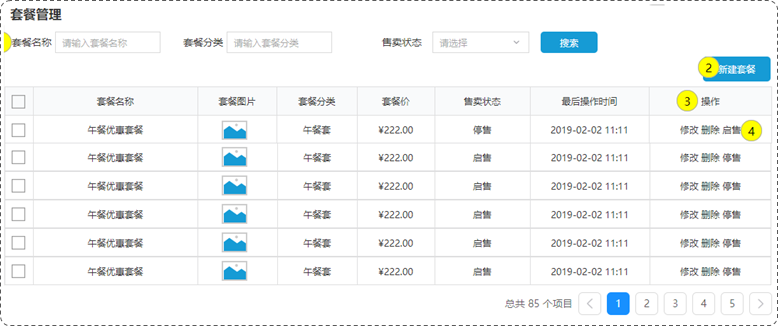
套餐的信息:套餐名称、套餐图片、套餐分类、套餐价格、套餐售卖状态、套餐的操作时间。
思考:套餐与菜品之间是什么关系?
- 思考逻辑:一个套餐下可以有多个菜品吗?反过来再想一想,一个菜品可以出现在多个套餐中吗?
答案:多对多关系。一个套餐下会有多个菜品,而一个菜品也可以出现在多个套餐中。
设计表原则:创建第三张中间表,建立两个字段分别关联菜品表的主键和套餐表的主键。
分析页面原型及需求文档后,我们获得:
- 分类表
- 业务字段:分类名称、分类类型、分类排序、分类状态
- 基础字段:id(主键)、分类的创建时间、分类的修改时间
- 菜品表
- 业务字段:菜品名称、菜品图片、菜品分类、菜品售价、菜品售卖状态
- 基础字段:id(主键)、分类的创建时间、分类的修改时间
- 套餐表
- 业务字段:套餐名称、套餐图片、套餐分类、套餐价格、套餐售卖状态
- 基础字段:id(主键)、分类的创建时间、分类的修改时间
表结构之间的关系:
- 分类表 - 菜品表 : 一对多
- 在菜品表中添加字段(菜品分类),关联分类表
- 菜品表 - 套餐表 : 多对多
- 创建第三张中间表(套餐菜品关联表),在中间表上添加两个字段(菜品id、套餐id),分别关联菜品表和分类表
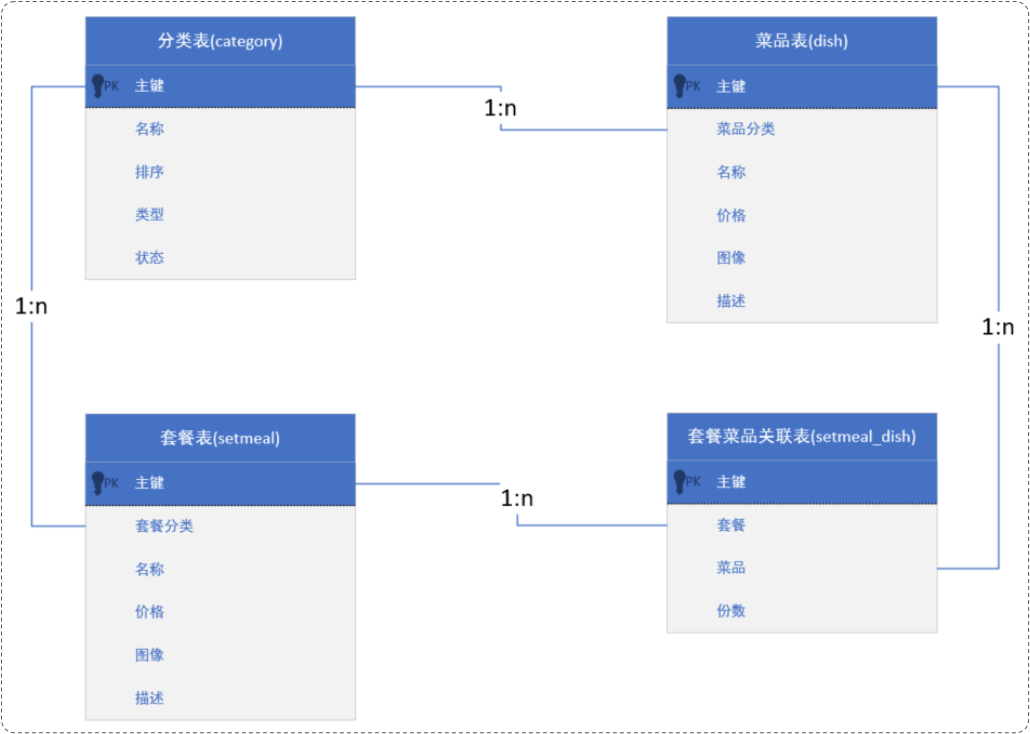
表结构
分类表:category
- 业务字段:分类名称、分类类型、分类排序、分类状态
- 基础字段:id(主键)、创建时间、修改时间
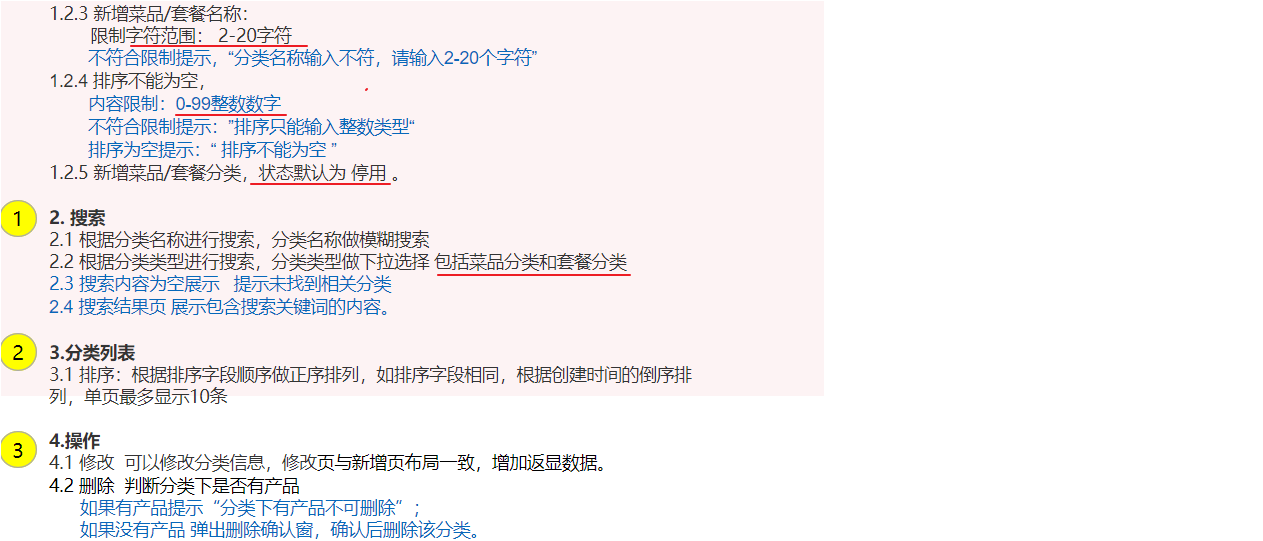
-- 分类表
create table category
(
id int unsigned primary key auto_increment comment '主键ID',
name varchar(20) not null unique comment '分类名称',
type tinyint unsigned not null comment '类型 1 菜品分类 2 套餐分类',
sort tinyint unsigned not null comment '顺序',
status tinyint unsigned not null default 0 comment '状态 0 禁用,1 启用',
create_time datetime not null comment '创建时间',
update_time datetime not null comment '更新时间'
) comment '菜品及套餐分类';菜品表:dish
- 业务字段:菜品名称、菜品图片、菜品分类、菜品售价、菜品售卖状态
- 基础字段:id(主键)、分类的创建时间、分类的修改时间

-- 菜品表
create table dish
(
id int unsigned primary key auto_increment comment '主键ID',
name varchar(20) not null unique comment '菜品名称',
category_id int unsigned not null comment '菜品分类ID', -- 逻辑外键
price decimal(8, 2) not null comment '菜品价格',
image varchar(300) not null comment '菜品图片',
description varchar(200) comment '描述信息',
status tinyint unsigned not null default 0 comment '状态, 0 停售 1 起售',
create_time datetime not null comment '创建时间',
update_time datetime not null comment '更新时间'
) comment '菜品';套餐表:setmeal
- 业务字段:套餐名称、套餐图片、套餐分类、套餐价格、套餐售卖状态
- 基础字段:id(主键)、分类的创建时间、分类的修改时间

-- 套餐表
create table setmeal
(
id int unsigned primary key auto_increment comment '主键ID',
name varchar(20) not null unique comment '套餐名称',
category_id int unsigned not null comment '分类id', -- 逻辑外键
price decimal(8, 2) not null comment '套餐价格',
image varchar(300) not null comment '图片',
description varchar(200) comment '描述信息',
status tinyint unsigned not null default 0 comment '状态 0:停用 1:启用',
create_time datetime not null comment '创建时间',
update_time datetime not null comment '更新时间'
) comment '套餐';套餐菜品关联表:setmeal_dish
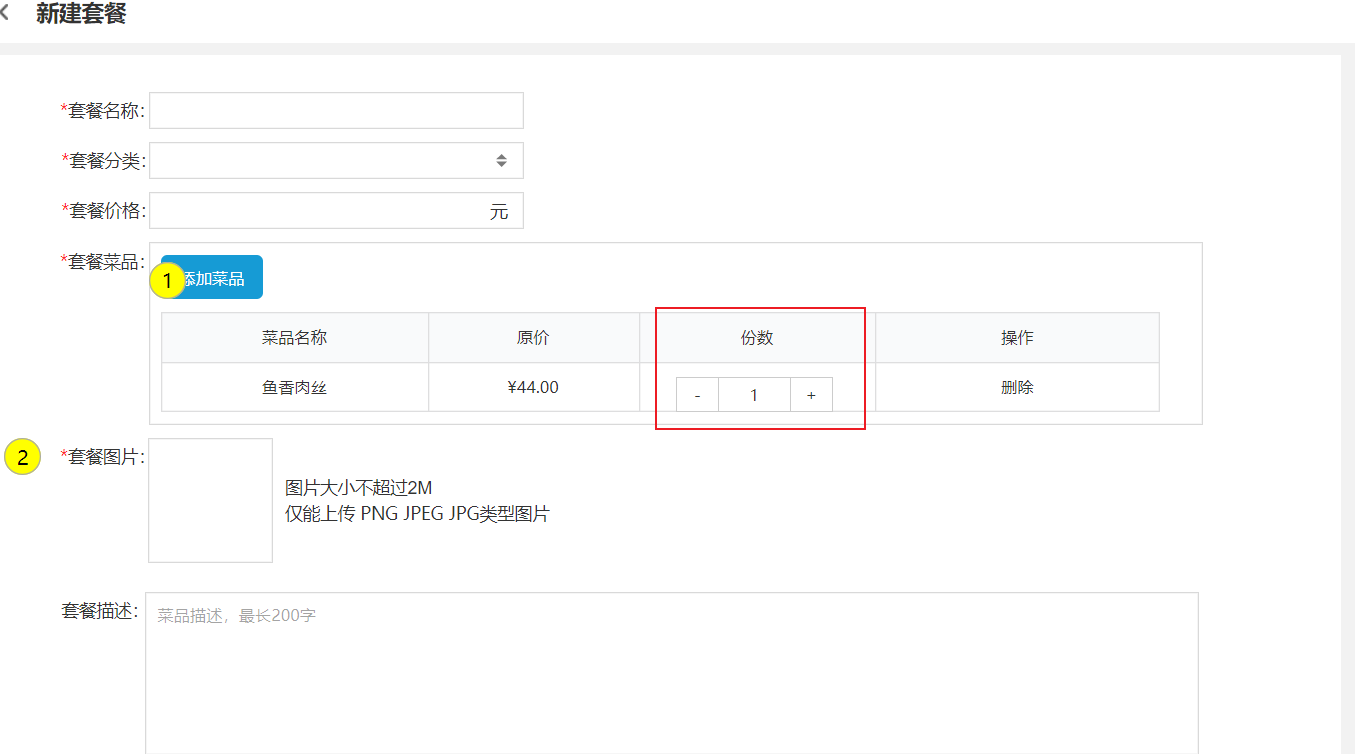
-- 套餐菜品关联表
create table setmeal_dish
(
id int unsigned primary key auto_increment comment '主键ID',
setmeal_id int unsigned not null comment '套餐id ', -- 逻辑外键
dish_id int unsigned not null comment '菜品id', -- 逻辑外键
copies tinyint unsigned not null comment '份数'
) comment '套餐菜品关联表';

